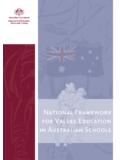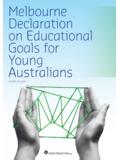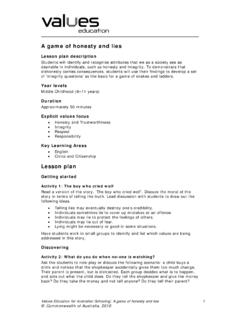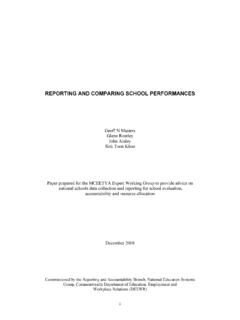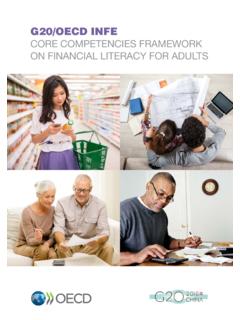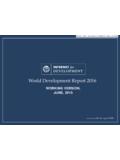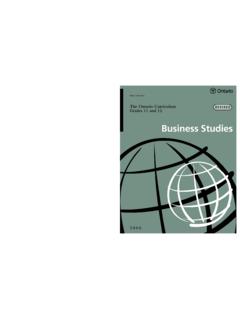Transcription of National Consumer and Financial Literacy Framework
1 National Consumer and Financial Literacy Framework September 2011. National Consumer and Financial Literacy Framework Audience Teachers and principals are the primary audience for this document. However, it is also highly relevant to the work of curriculum developers and curriculum support staff in state and territory government and non-government education authorities, pre- service teacher educators, and teacher professional associations. Overview This document is a revised version of the National Consumer and Financial Literacy Framework (the Framework ) originally developed in 2005. It articulates a rationale for Consumer and Financial education in Australian schools; describes essential Consumer and Financial capabilities that will support lifelong learning; and provides guidance on how Consumer and Financial education may be structured to support a progression of learning from Foundation Year 10.
2 Companion resources to this Framework , being developed by the Australian Securities and Investments Commission (ASIC), provide further guidance about integrating Consumer and Financial education into specific learning areas of the Australian Curriculum. These companion resources are available at: Further information Enquiries about this document should be directed to: Additional copies This document can be accessed at Related documents Melbourne Declaration on Educational Goals for Young Australians (MCEETYA, 2008). National Financial Literacy Strategy (ASIC, 2011). Financial Literacy and Behavioural Change (ASIC, 2011). Related links Acknowledgements ASIC led the revision of the National Framework in consultation with the Australian Government Financial Literacy Board, ASIC's National Reference Group Consumer and Financial Literacy , and other key Consumer and education stakeholders.
3 Contents 5 Introduction 6 Purpose and scope 7 Background National education context International context 10 Consumer and Financial Literacy Defining Consumer and Financial capabilities Dimensions Progression of student learning: Foundation Year 10. 26 Appendix 1. Links to the Australian Curriculum's general capabilities Links to the Australian Curriculum's cross-curriculum priorities 29 Appendix 2. Acknowledgements National Consumer AND Financial Literacy Framework Introduction Knowing how to manage personal finances is one of the most important and challenging features of everyday life. It is a core skill in today's world. It affects quality of life, the opportunities individuals and families can pursue, their sense of security and the overall economic health of Australian Young people today are interacting with money and making Consumer choices from an early age.
4 They are growing up in a fast paced Consumer society where money is increasingly invisible', where there is a growing range of choice and complexity in Consumer and Financial products, increasing use of online and digital environments for shopping and making Financial transactions,2 and where individuals carry a greater level of responsibility for the decisions they make in these contexts. Students who are currently at school, will also face a number of social, economic and moral challenges in their lifetimes that will impact on their lives and choices such as increasing global interconnectedness, both on a personal level and more broadly; climate change; the ageing of the population; and scarcity of natural Effective Consumer and Financial education empowers students in the face of such challenges.
5 It contributes to students' cognitive, personal and social development and develops the capabilities needed to address their short-term Consumer and Financial issues and concerns as well as shape their social and economic futures. Students have opportunities to learn: how to manage their finances4 and plan for needs and wants, now and into the future the language of money, how to navigate the ever-changing Consumer and Financial landscape and where to go to for assistance about the rights and responsibilities of consumers in modern society and the wider impact of everyday Consumer and Financial decisions to develop a range of enterprising 1. National Financial Literacy Strategy, (ASIC, 2011). 2. Australians' use of the Internet as part of their everyday lives for banking, shopping, education and communication has grown rapidly over the past decade.
6 According to Roy Morgan's State of the Nation report (March 2011), the majority of Australians aged 14 and over are now online more than once a day and for the first time, online banking has overtaken branch visits, with of consumers preferring this method of interaction with their Financial service provider. Furthermore, the increase in Internet access and the growth of Internet banking has led to a dramatic rise in purchasing goods and services on the Internet over the last ten years. In December 2010, a majority (51%) of Australians had shopped online, compared to just in June 1999. This trend looks set to continue to rise. 3. National Strategy for Young Australians, (Australian Government, 2010). 4 Managing finances includes matters related to spending and saving; credit and debt; and Financial decision-making.
7 Students learn about strategies (including use of IT and online tools) to keep track of everyday Financial transactions. 5 In the context of this Framework , enterprising behaviours cover a range of skills including adaptability, initiative, communication, managing and leading and problem-solving and the associated behaviours such as: working productively with others towards common goals, interpersonal competence, flexibility and adaptability, planning and organising, using resources effectively, analysing issues and managing identified risks. 5. National Consumer AND Financial Literacy Framework . Purpose and scope The purpose of this Framework is to: provide a rationale for Consumer and Financial education in Australian schools describe essential Consumer and Financial capabilities that will support lifelong learning provide guidance on how Consumer and Financial education may be structured to support a progression of learning from Foundation Year 10.
8 Companion resources to the Framework provide further guidance about integrating Consumer and Financial education into the specific learning areas of the Australian Curriculum. In its capacity as the Australian Government agency with responsibility for Financial Literacy policy and initiatives, the Australian Securities and Investments Commission (ASIC) led the revision of the Framework6 in consultation with the Australian Government Financial Literacy Board,7 representatives from the Commonwealth and state and territory education sectors and Consumer affairs agencies8 and selected teacher professional This revision takes account of National and international research on Financial Literacy , international best practice in Financial education,10 the advent of the Australian Curriculum, and the rapid advances in technology that influence the everyday lives of Australians.
9 The scope of student learning in the Framework spans Foundation Year 10. The Framework builds on the learning outcomes of the Early Years Learning Framework11 and recognises the diversity of family, cultural and community backgrounds that students bring with them to school. Teachers are encouraged to consolidate and extend Consumer and Financial education into the senior years of schooling. It is in these years that students develop a growing personal familiarity and engagement with Consumer and Financial contexts, making it more likely for them to develop deep understandings and appreciate connections between concepts. 6. The importance of building Consumer and Financial capabilities in Australian students was agreed nationally for the first time in 2005 and a National Consumer and Financial Literacy Framework was developed under the auspices of the then Ministerial Committee for Education, Employment, Training and Youth Affairs (MCEETYA).
10 7 See for information about the Financial Literacy Board. 8. See Appendix 2 for more information. 9. The Australian Association for Mathematics Teachers, the Australian Science Teachers Association, Business Educators Australasia and the Victorian Association for the Teaching of English were consulted on the draft revised Framework . These associations provided recommendations to ASIC in 2010 /2011 on how the National Framework could be improved. 10. The revised Framework has drawn on guidance material developed by the OECD's International Network on Financial Education to support Financial education at school [INFE (2011)9] as well as the Financial education frameworks of a number of countries, specifically, Financial education for 7 19 year olds in Wales (Welsh Assembly Government, 2010).
